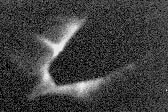

WINT O GREEN LIFESAVER FLASHES!
An explanation with pictures of why wintogreen lifesavers flash when bitten
For years I've heard about the flash of light that's supposed to occur when a wintergreen lifesaver is crushed, but never believed is was true. Finally, I tested it and was delighted to discover that the flash really does happen. It's extremely faint, quick, and has a cyan color. I failed several times to capture the event on film. Even ASA 800 film was far to slow to capture the flash. Success came when I used Kodak's TMAX ASA 3200 black and white film and had it push processed to ASA 6400. The picture below, after my photo processor optically enhanced it, was the result. The wedge-shaped object surrounded by the flash is the tip of a pair of needle-nosed pliers as they crushed the lifesaver to cause it to flash. Simply breaking the lifesaver didn't produce enough light to record.

What Causes Wintergreen Lifesavers to Flash
When a lifesaver is broken, the positive and negative charges in the sugar molecules split, creating an electric field across the break. This field is strong enough to excite nitrogen molecules in the air with the result that they reemit the energy they absorbed from the electric filed in a burst of ultraviolet radiation, which we can't see. This radiation is then absorbed by the wintergreen oil that is used to flavor the lifesaver. This energy is then emitted as a flash of blue light that we can see.
UPDATE!!! Several
years after posting this page I decided to try again to capture
images of a wintergreen flash, this time with my new Canon EOS 20D
digital camera. I set the ASA (ISO) to 3200 and used an extension
ring to get as close to the lifesaver as possible so that most of the
light would go into the lens. The first shot is similar to the one
above in that the lifesaver was crushed with the upper jaw of the
plier blocking the direct view of the flash.

Even at ISO 3200 the original image was completely black. I had to increase the contrast 96 percent to bring out the image, with the result that a lot of noise was introduced. Still, the image is larger and in color, which is better than my first attempt. Similar to the first attempt there are bright rays emanating along fracture lines in the lifesaver that look brighter because they emit light directly into the camera. All the other light was emitted under the plier jaw and had to diffuse outward through the lifesaver to be visible.
The next two images used broken lifesavers so I could photograph the flash across the face of the area being crushed. In both pictures the jaws of the plier are on the left and right sides of the lifesaver. Note the complex pattern of light caused by the brightest light coming from fractures propagating across the face of the lifesaver. The outline of the lifesaver's cross section can just be made out in the image on the right.
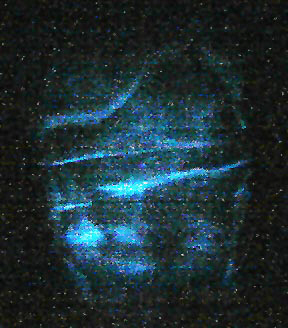

All of these photos, especially the last two, are many times actual size.
Two
final notes about wintergreen lifesavers and their flash: First, as
of 2005 in southern California it is impossible to find the
traditional rolls of wintergreen lifesavers. I looked in six
different stores and none carried rolls of wintergreens. The only
wintergreens I could find were in large bags. Second, the
wintergreens in the bags do not have any wintergreen oil in them,
just artificial flavors, making the explanation I found on the
Internet and repeated above suspect. After researching this I
discovered that the active flavoring in oil of wintergreen is methyl
salicylate, a distant relative of aspirin. Like aspirin, this
chemical can be obtained from natural sources or manufactured in a
laboratory. Since it's cheaper to make it than collect it from
nature, manufactured methyl salicylate is used and therefore has to
be listed as an artificial flavoring. This means that the explanation
above is still valid.
UPDATE: Continued searching finally turned up rolls of wintogreen lifesavers. I found them to be slightly smaller than the bagged types and denser. They seem to produce better flashes as the image below shows:
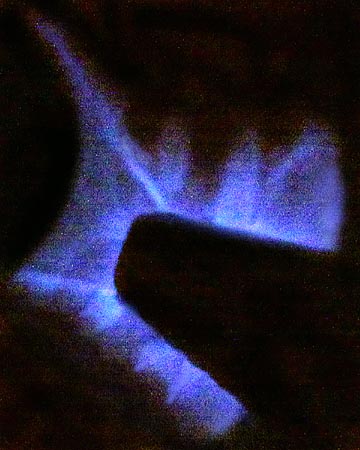
This image was captured using a Canon 50D, 15.1 megapixel camera set to ISO 12,800. Although this extremely high ISO sensativity introduces a lot of noise, it greatly reduces the amount of pushing required during processing to bring out the details of the flash. The curve on the upper left is the edge of the hole in the middle of the wintogreen lifesaver. The larger arc in the lower right is the outside of the lifesaver.
NEW CAMERA UPDATE!!
While reviewing this page recently, I noticed that I hadn't used my new Canon 6D camera to take new pictures. This camera tops out at ISO 102,400, almost ten times the 50D.
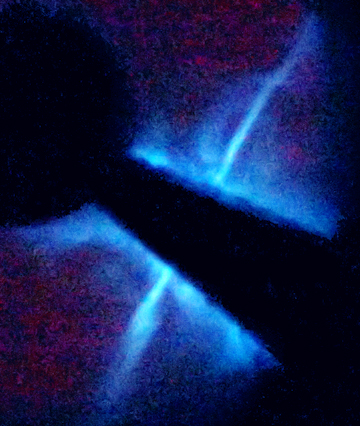
The dark wedge is the tip of the needle nose pliers used to crush the wintogreen lifesaver.
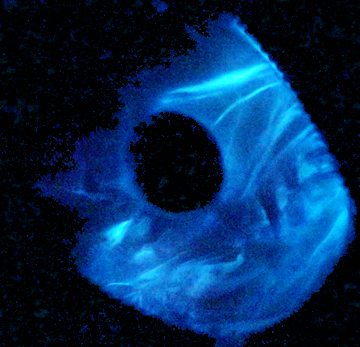
This shot is of the lifesaver being crushed across its diameter.
Whereas all of the previous images requires considerable brightening in Photoshop, the extremely high ISO of the 6D and the comparatively low noise for that ISO allowed the last two images to be posted with almost no brightening.
One
final note is that many sugar-based candies will emit weak flashes
when crushed. It is a common result caused by fracturing sugar
molecules. The problem is that the flashes in all other sugar candies
are so weak that they are almost impossible to see. Only candies with
methyl salicylate flash brightly enough to be seen easily.
Unfortunately, this chemical is bulk listed in the ingredients block
as one of the "other artificial and natural flavors" so you
can't tell if that particular candy does or doesn't have it.
The following provides video and additional images of wintogreen lifesaver flashes:
This flashing light that results when something is broken is called triboluminescence and is common in many materials, particularly crystals. Perhaps the oddest example of troboluminescence comes from quickly tearing glow-in-the-dark Silly Putty. Unlike wintergreen lifesvers, the flash is extremely weak and the only image I could get of it is of very poor quality. Such as it is, it can be seen half way down the Silly Putty page.
(Click on main site to browse 70 other topics ranging from exotic kaleidoscope designs to the strange world of lucid dreaming.)